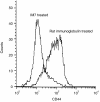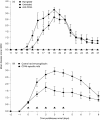CD44 is involved in selective leucocyte extravasation during inflammatory central nervous system disease
- PMID: 10583604
- PMCID: PMC2326932
- DOI: 10.1046/j.1365-2567.1999.00894.x
CD44 is involved in selective leucocyte extravasation during inflammatory central nervous system disease
Abstract
Clinical signs of experimental autoimmune encephalomyelitis (EAE) are associated with the selective recruitment of CD4+ memory (CD45RBlow CD44high) T cells into the central nervous system (CNS). However, we have found that many of these recently recruited memory cells are CD44low, suggesting that the CD44 antigen may be involved in, and transiently lost during, the extravasation process. Indeed, administration of a CD44-specific antibody (IM7.8.1) induced leucocyte CD44 shedding and both prevented the development and ameliorated the severity of established EAE by inhibiting mononuclear cell infiltration into the CNS. Trafficking of cells into lymph nodes, however, a property mainly of naïve cells, was essentially unaffected. In contrast, treatment with antibody to very late activation antigen-4 (VLA-4) prevented homing to both the CNS and to lymph nodes. This study contests previous reports that dismissed a role for CD44 in inflammation of the CNS and, coupled with observations in murine dermatitis and arthritis, suggests that CD44 is involved in the homing of primed lymphocytes to sites of inflammation. CD44 should therefore be considered a target for immunotherapy of T-cell-mediated inflammatory diseases, such as multiple sclerosis.
Figures




Similar articles
-
Antibodies to CD44 and integrin alpha4, but not L-selectin, prevent central nervous system inflammation and experimental encephalomyelitis by blocking secondary leukocyte recruitment.Proc Natl Acad Sci U S A. 1999 Jun 8;96(12):6896-901. doi: 10.1073/pnas.96.12.6896. Proc Natl Acad Sci U S A. 1999. PMID: 10359810 Free PMC article.
-
Discordant effects of anti-VLA-4 treatment before and after onset of relapsing experimental autoimmune encephalomyelitis.J Clin Invest. 2001 Apr;107(8):995-1006. doi: 10.1172/JCI11717. J Clin Invest. 2001. PMID: 11306603 Free PMC article.
-
Direct demonstration of the infiltration of murine central nervous system by Pgp-1/CD44high CD45RB(low) CD4+ T cells that induce experimental allergic encephalomyelitis.J Neuroimmunol. 1992 Sep;40(1):57-69. doi: 10.1016/0165-5728(92)90213-5. J Neuroimmunol. 1992. PMID: 1381382
-
Immune cell entry to central nervous system--current understanding and prospective therapeutic targets.Endocr Metab Immune Disord Drug Targets. 2009 Dec;9(4):315-27. doi: 10.2174/187153009789839219. Endocr Metab Immune Disord Drug Targets. 2009. PMID: 20028334 Review.
-
Lymphocyte targeting of the central nervous system: a review of afferent and efferent CNS-immune pathways.Brain Pathol. 1996 Jul;6(3):275-88. doi: 10.1111/j.1750-3639.1996.tb00855.x. Brain Pathol. 1996. PMID: 8864284 Review.
Cited by
-
Hyaluronan anchored to activated CD44 on central nervous system vascular endothelial cells promotes lymphocyte extravasation in experimental autoimmune encephalomyelitis.J Biol Chem. 2012 Sep 28;287(40):33237-51. doi: 10.1074/jbc.M112.356287. Epub 2012 Aug 3. J Biol Chem. 2012. PMID: 22865853 Free PMC article.
-
Inhibition of Rho GTPases with protein prenyltransferase inhibitors prevents leukocyte recruitment to the central nervous system and attenuates clinical signs of disease in an animal model of multiple sclerosis.J Immunol. 2002 Apr 15;168(8):4087-4094. doi: 10.4049/jimmunol.168.8.4087. J Immunol. 2002. PMID: 11937568 Free PMC article.
-
A TLR/CD44 axis regulates T cell trafficking in experimental and human multiple sclerosis.iScience. 2022 Jan 11;25(2):103763. doi: 10.1016/j.isci.2022.103763. eCollection 2022 Feb 18. iScience. 2022. PMID: 35128357 Free PMC article.
-
Distinct migratory pattern of naive and effector T cells through the blood-CSF barrier following Echovirus 30 infection.J Neuroinflammation. 2019 Nov 21;16(1):232. doi: 10.1186/s12974-019-1626-x. J Neuroinflammation. 2019. PMID: 31752904 Free PMC article.
-
Prediction of CD44 Structure by Deep Learning-Based Protein Modeling.Biomolecules. 2023 Jun 28;13(7):1047. doi: 10.3390/biom13071047. Biomolecules. 2023. PMID: 37509083 Free PMC article.
References
-
- O’Neill JK, Baker D, Davidson AN, et al. Control of immune‐mediated disease of the central nervous system with monoclonal (anti‐CD4) antibodies. J Neuroimmunol. 1993;45:1. - PubMed
-
- Allen SJ, Baker D, O’Neill JK, Davison AN, Turk JL. Isolation and characterization of cells infiltrating the spinal cord during the course of chronic relapsing experimental allergic encephalomyelitis in the Biozzi AB/H mouse. Cell Immunol. 1993;146:335. - PubMed
-
- Gallatin WM, Weissman IL, Butcher EC. A cell‐surface molecule involved in organ‐specific homing of lymphocytes. Nature. 1983;304:30. - PubMed
-
- Bradley LM, Watson SR. Lymphocyte migration into tissue: the paradigm derived from CD4 subsets. Curr Opin Immunol. 1996;8:312. - PubMed
-
- Springer TA. Traffic signals for lymphocyte recirculation and leukocyte emigration: the multistep paradigm. Cell. 1994;76:301. - PubMed
Publication types
MeSH terms
Substances
Grants and funding
LinkOut - more resources
Full Text Sources
Other Literature Sources
Research Materials
Miscellaneous

